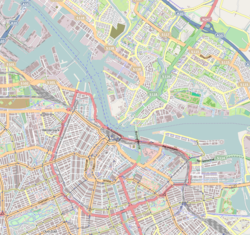Museum Van Loon: Difference between revisions
Information from the official museum website |
No edit summary |
||
| Line 29: | Line 29: | ||
}} |
}} |
||
'''Museum Van Loon''' is a [[museum]] located in a [[canal]]side private residence alongside the exclusive and prestigious [[Keizersgracht]] in [[Amsterdam]], the [[Netherlands]]. The museum is named after the aristocratic Van Loon family that have been living in the house since the 19th century. Seven days a week the family opens their home and private art collection to the public. |
'''Museum Van Loon''' is a [[museum]] located in a [[canal]]side private residence alongside the exclusive and prestigious [[Keizersgracht]] in [[Amsterdam]], the [[Netherlands]]. The museum is named after the [[Aristocracy|aristocratic]] Van Loon family that have been living in the house since the 19th century. Seven days a week the family opens their home and private art collection to the public. |
||
==History== |
==History== |
||
Revision as of 04:17, 15 September 2015
 The museum as seen from the garden | |
| Established | 1973 (museum) |
|---|---|
| Location | Keizersgracht 672 Amsterdam, Netherlands |
| Website | www.museumvanloon.nl |
Museum Van Loon is a museum located in a canalside private residence alongside the exclusive and prestigious Keizersgracht in Amsterdam, the Netherlands. The museum is named after the aristocratic Van Loon family that have been living in the house since the 19th century. Seven days a week the family opens their home and private art collection to the public.
History
The canal house where the museum resides was built in 1672, and served as the home of artist Ferdinand Bol. From 1884 to 1945 the Van Loons lived in the house. Thora van Loon-Egidius, who lived in the house, was a lady-in-waiting for Wilhelmina of the Netherlands.[1]
Architecture and collection
The interior of the house has been renovated, and appears reminiscent of its look in the 18th-century, with wood paneling and stucco work. The upstairs features several paintings of Roman sports figures and a bedroom that is decorated with a Romanticism period painting of Italy. The house also has fake bedroom doors: the 18th-century owners desires to lack symmetry in the interior design so they painted the real bedroom doors to match the walls and fake doors to appear real in a location where one would assume a door would be.[1]
References
External links
- Museum Van Loon (official website)

